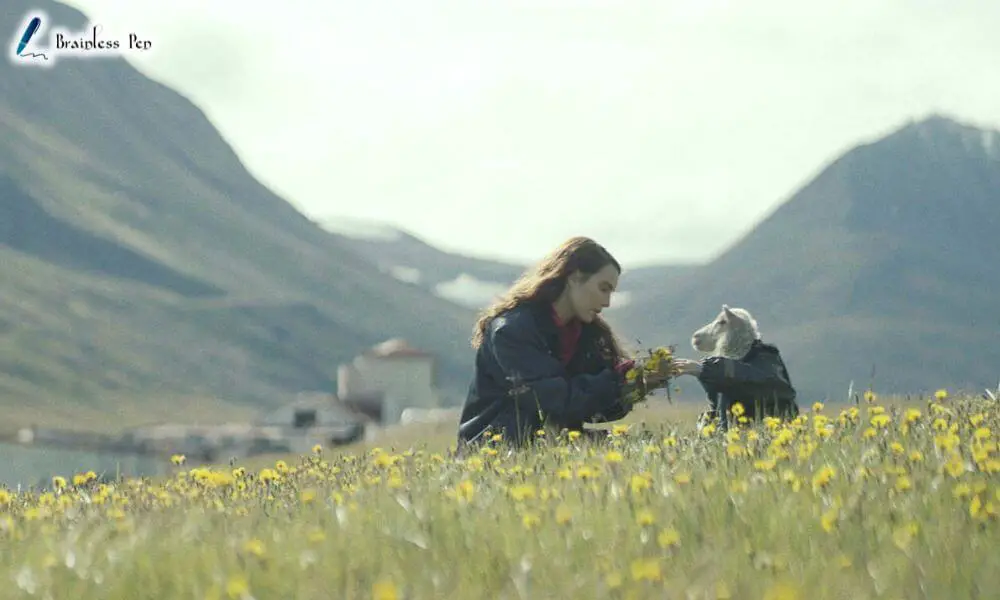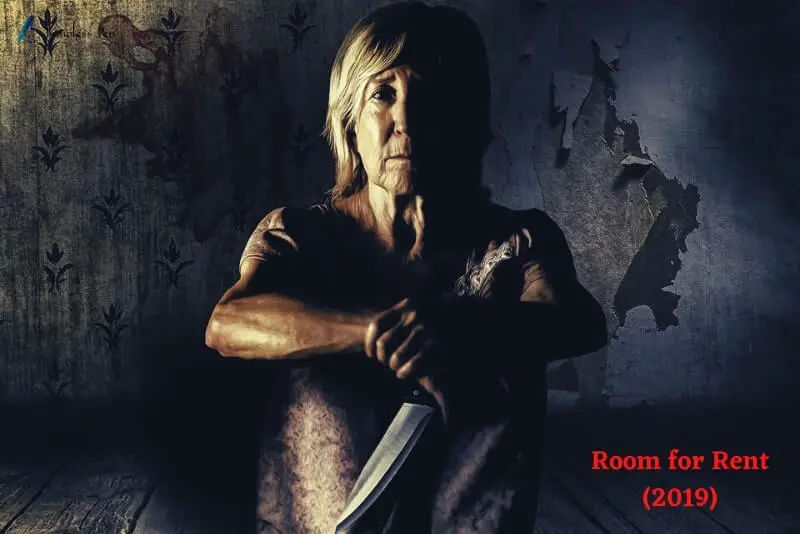Last updated on October 3rd, 2024 at 10:55 pm
Lamb is a haunting and enigmatic film that tells the story of Maria (Noomi Rapace) and Ingvar (Hilmir Snaer Guðnason), a couple who live on a remote Icelandic farm and are struggling to come to terms with a tragic loss.
The movie opens with Maria and Ingvar going about their daily routines in a stark and unforgiving landscape, and as the movie progresses, we learn more about the source of their pain: they lost their infant daughter to stillbirth. Maria’s memory of the child’s memory haunts her, and she sees strange visions that blur the line between reality and fantasy.

The movie follows them on a journey to find their lost daughter, fraught with danger and uncertainty. The ending is mysterious and deeply moving, and the symbolism and themes of the movie’s message about loss and longing are explored.
* * * Spoiler Alert – If you haven’t seen the movie yet, turn back now! * * *
Lamb (2021) Ending Explained

So, you’ve just finished watching the movie Lamb (2012), and you’re left scratching your head about the ending. What exactly happened, and what does it mean? Don’t worry; you’re not alone! The ending of Lamb is a complex and enigmatic sequence that invites multiple interpretations.
The movie’s ending is a powerful and striking image that raises many questions about the meaning and significance of the ending. One interpretation is that it represents a moment of transformation and redemption for the characters, as the couple at the center of the story struggles with intense grief and loss.
The transformation of the lamb into a human child can be seen as a metaphor for the couple’s transformation and healing, as it represents a new beginning, a fresh start, and a chance for the couple to find a way forward. The ending is a testament to the power of cinema to provoke thought and emotion and to challenge viewers to engage with complex ideas and themes.
The ending of Lamb is a powerful and memorable moment that invites viewers to engage meaningfully with its themes and ideas.
Analysis of the Ending of Lamb (2021)

The final scene of Lamb takes place in a remote cabin, where Maria and Ingvar have brought a lamb in search of its mother. When they arrive, they find that the mother has died and the lamb is left alone and vulnerable.
They are then visited by mysterious figures who appear to be the lamb’s true owners. At this point, the movie takes a surreal turn as the lamb transforms into a human child, naked and covered in blood. Maria is overcome with emotion and takes the child into her arms, and the child’s cries slowly turn into the sound of a lamb bleating.
The lamb child symbolizes Maria’s lost daughter and their longing to bring her back to life, while the lamb child symbolizes the fragility and vulnerability of life itself.
The mysterious figures dressed in white add to the sense of otherworldliness and mystery, while the child’s nakedness and blood suggest a sense of primal, raw energy, and its cries transform into a lamb’s bleat, adding to disorientation and ambiguity.
Explanation Of The Symbolism And Imagery In The Ending Scene

The ending of Lamb is a powerful and thought-provoking exploration of loss, grief, and the search for meaning in the face of trauma.
The transformation of the lamb into a human child is a moment of surreal and haunting beauty that speaks directly to these central themes. Maria and Ingvar’s willingness to take the lamb on a journey to find its mother reflects their desire to find meaning and purpose in their lives after the loss of their daughter.
The film’s depiction of the lamb as a symbol of innocence and vulnerability is a powerful metaphor for the experience of loss and grief. Lamb leaves a lasting impression on the viewer and invites us to ponder life’s and death’s mysteries long after the credits have rolled.
Possible Interpretations Of The Movie Ending
Different Interpretations of the Ending Are Based On Themes And Symbolism

One possible interpretation is that the film mediates the cycle of life and death and how we must confront the harsh realities of mortality to find meaning and purpose in our lives.
The lamb’s transformation into a human child could be seen as a representation of the cyclical nature of life and the idea that death is not an end but rather a transformation into something new and different.
Another possible interpretation is that the film is a commentary on the nature of reality and how our perceptions and beliefs shape our understanding of the world.
The appearance of the figures dressed in white and the lamb’s transformation into a human child could be seen as an expression of the idea that reality is not fixed but rather shaped by our subjective experiences and interpretations.
Each Interpretation Sheds Light On The Movie’s Central Ideas And Questions

The ending of Lamb explores loss, grief, renewal, and the cyclical nature of life and death. It also explores the complex and often contradictory emotions that accompany experiences of loss and trauma and how our perceptions of the world can be shaped and distorted by our subjective experiences and beliefs.
Some Common Questions, Confusions, and Answers
What makes Lamb a unique and memorable film?
Lamb is a unique and memorable film because it pushes the boundaries of storytelling and challenges viewers to engage with complex themes in innovative and thought-provoking ways.
ill you understand the ending of Lamb?
The ending of Lamb is open to interpretation, and viewers may have different understandings of its meaning. However, the film invites viewers to engage with its central themes and ideas in a deeply personal and meaningful way.
What is the symbolism of the lamb in the movie?
The lamb in the movie symbolizes innocence and vulnerability, as well as a metaphor for the experience of loss and grief.
Why does the lamb turn into a human child at the movie's end?
The transformation of the lamb into a human child at the movie's end is a surreal and haunting moment that invites viewers to engage with the film's central themes and ideas.
What is the significance of the Icelandic setting in the movie?
The Icelandic setting in the movie serves as a powerful backdrop for the film's exploration of themes of loss, grief, and transformation. Iceland's stark and otherworldly landscape serves as a metaphor for the emotional terrain the characters are navigating.
Final Verdict and Recommendations

So, what’s the final verdict on Lamb (2012) and its ending? While the movie may not be for everyone, it’s a thought-provoking and deeply emotional film that rewards viewers who are willing to engage with its themes and ideas.
If you’re a fan of arthouse cinema or indie dramas exploring complex emotional terrain, Lamb is worth watching. The film is beautifully shot, with a haunting and atmospheric score that adds to the overall mood and tone.
As for the ending, it’s a powerful and striking sequence that invites multiple interpretations. Whether you see it as a moment of transformation and redemption, a surreal and haunting image, or something else, the ending will surely leave an impression.
Overall, Lamb is a challenging and rewarding film worth your time. Just be prepared to engage with its themes of loss, grief, and the search for meaning, and be ready for an ending that will leave you thinking and reflecting long after the credits have rolled.
Summary
Original Title: Dýrið
Other Titles: Lamb
Genre: Horror/ Fantasy/ Drama
Runtime: 1hr 46min
Original Language: Icelandic
Directed by Valdimar Jóhannsson
Written by Sjón, Valdimar Jóhannsson
Tagline: Mother. Nature.
Release date: September 24, 2021 (Iceland)
Origin Country: Iceland, Sweden, Poland
Filming locations: Iceland
Cast of Characters
Actor/Actress Name
Characters Name
| Actor/Actress Name | Character Name |
| Noomi Rapace | Maria |
| Hilmir Snær Guðnason | Ingvar |
| Björn Hlynur Haraldsson | Pétur |











